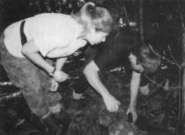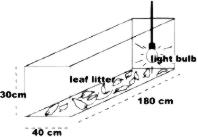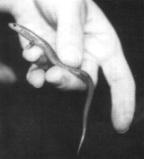Return To Reptiles Page

The CRC for Tropical Rainforest Ecology and Management Shrinking forests -
what lizards can tell us about
fragmented rainforest habitats
Tropical forests are the Earth's most biologically diverse ecosystems. To properly manage these unique areas, it is important to understand the effects that reduced size and fragmentation of the forests have on their inhabitants. It seems inevitable that small 'islands' of rainforest will become the last refuges of many rainforest species. These 'islands' or fragments may become the 'seeds' from which to re-establish extensive forests in the future.
Why study fragments?
Studying the effect of fragmentation is important because small isolated populations of animals and plants tend to decline in genetic diversity This is a problem as it can reduce their ability to respond to changing environmental factors or to new diseases or parasites. Another effect of fragmentation is the changes caused to the physical environment. Plants and animals are more likely to be exposed to what are known as 'edge effects'. As a block of forest becomes fragmented, there is an incease in the amount which is edge.
Edge effects are numerous and include factors such as increased sunlight reaching the forest floor with associated drying effects. Temperatures are consequently hotter and more variable, and humidity is lowered. Increased wind shear results in greater numbers of fallen trees which further opens up the canopy. The changed environmental conditions cause changes to sensitive insect populations, and predatory behaviour by birds increases due to the more open canopy. These are just some of the direct effects of increasing the amount of edge.

Researchers, Joanna Summer and Craig Moritz,
find skinks by rolling logs and catching them by hand Why use lizards to study forest fragmentation?
Most previous studies have focused on birds and mammals, and their responses at the community rather than individual level. To make statistically valid conclusions regarding individual species, you need large sample sizes.
The scale that is investigated is very different when looking at lizards compared to mammals or birds. This is because lizards are usually much smaller than birds and mammals, they do not move such large distances, and have smaller home ranges. In terms of habitat fragmentation, this means that the size of a forest fragment which can hold a healthy population of reptiles is likely to be different to that which can hold a healthy population of either birds or mammals.
Studies of the effects of fragmentation on reptiles are rare, but since they are known to adapt quickly to environmental change, especially in 'island' systems, they are an ideal candidate for studying changes to shape or size. The two research stories described here are about forest skinks which are abundant in the wet tropics and easy to capture. Therefore, it has been possible to have good sample sizes which are suitable for individual studies.
Skinks are a family of lizards widely distributed across Australia. They have evolved into many species in the Australian desert and Australia outranks other countries in terms of the number of skink species. Despite this fact the biology of skinks is poorly understood, and very few Australians are even aware of their existence. This is probably due to the fact that they are, for the most part, small, cryptic and often overlooked in favour of larger, more obvious animals. Researching skinks in rainforest fragments
Simon Cook is a PhD student who is studying at James Cook University in Townsville. The purpose of his research is to determine the diversity of skink species living in tropical rainforest and the difficulties they might have faced in the long evolutionary path needed to evolve from desert skinks to rainforest skinks. Simon's studies are concentrating on the importance of temperature. Lizards rely on gaining heat from the environment to perform normal bodily functions such as digestion of food and reproduction, and may also rely on heat from the sun to warm them up in the morning so that they can commence their daily activities.
Joanna. Stunner, a PhD student at The University of Queensland in Brisbane, has been studying the effects of forest fragmentation on one particular skink species-the prickly forest skink, Gnypetoscincus queenslandiae (Figure 2). In particular she has studied population densities, and differences in size and shape among populations of the lizard skink in both rainforest fragments and areas of continuous rainforest. She chose to study the skink populations of the Atherton Tableland where there are a large number of rainforest fragments.
Simon and Joanna are both participants in the Rainforest CRC. They have undertaken their research separately, but there are some interesting similarities in their findings. Both studies are summarised in this information sheet.
Hot and cold running skinks
There are two major strategies developed by skinks to deal with living in a cool rainforest environment. Skinks in the rainforest are either 'heliotherms' or 'thigmatherms'. Heliotherms actively seek sunny spots to warm their bodies. In the rainforest the opportunity for basking in sunlight is limited by the closed canopy of the forest, therefore most of the heliotherm species are limited to areas such as recent tree falls, where sunlight can reach the ground. Thigmatherms don't need to seek sunny positions to warm their bodies, they are able to be active at the temperature of the surrounding environment.
Simon conducted laboratory experiments by putting skinks in a long tank which is hot at one end and cold at the other (Figure 1). He allowed the lizards to choose the place they liked in the tank, and then measured the environmental temperature in that preferred location. This preferred environmental temperature in the tank was then compared with the temperature in their rainforest microhabitats. The results show that their distribution in rainforest is largely dictated by their temperature requirements, although Joanna's results (below) show that the availability of suitable homes is also a factor.
While heliotherms may be vulnerable to predators such as birds as they sit in the sun warming up, they are extremely quick and rely on their speed to avoid being caught. Thigmatherms move more slowly but rarely expose themselves to predators, as they forage under the leaf litter and in the darker areas of the forest. 
Figure 1 The thermal gradient used to determine preferred temperatures of different skink species in the lab.
The tank sits in a cold room at a constant temperature of 16°C
Skink lifestyle may determine where they prefer to live
These differences in lifestyle may explain the different distributions of the species in these wet tropical forests. The heliotherm species are capable of living in eucalypt forests, as they have not given up the heat-loving lifestyle of their more open country relatives. The thigmatherms, however, are incapable of moving into hot, dry eucalypt forests - they have become rainforest specialists. The result of this is that although thigmatherms can use a greater area of the rainforest, they are less capable of moving between isolated areas of rainforest. Heliotherms such as the red throated rainbow skink (Carlia rubrigularis, Figure 3) are fairly common in all the rainforest areas of the wet tropics and can be easily found basking in sunspots for the majority of the year.
Are changes in light gaps making prickly forest skinks vulnerable to extinction?
Simon's research has shown that there is a minimum canopy opening size which the red throated rainbow skink can occupy to ensure that it gets enough sunlight to have time to forage and digest food. These skinks can sometimes be seen chasing each other out of a particularly favourable sun spot. Artificial canopy openings such as roadsides, have produced far more habitat for this species than would normally be available, as tree fall gaps are usually quickly filled by young trees. This has allowed the species to expand its range within the rainforest.
The thigmatherm. skinks such as the prickly forest skink (Gnypetoscincus queenslandiae), are more restricted in range, being found only on the Atherton Tableland and around the Daintree area. This skink is a true rainforest resident. It lives under and within rotting logs on the rainforest floor. Studies have found that prickly skinks tend to remain in the vicinity of the same log for their lifetime and are never found outside the rainforest. Prickly skinks are generally active only on wet nights. They have become such specialised rainforest animals that it is extremely difficult for them to colonise new areas, and so they are basically restricted to the rainforest patch they are presently inhabiting. This may mean that increased forest fragmentation and clearing may make thigmathermic species more vulnerable to extinction.
Simon is continuing his research on the distribution patterns of these species and their preferred temperatures, and this will enable prediction of the effects of changes to the environment on these fascinating creatures.  Figure 2 Prickly forest skinks are dark brown in colour, with a rough rather than a shiny skin like common garden skinks. After moulting, the striped orange of the skin on their legs is much more visible - most of the time they are too muddy for the stripes to be obvious! Figure 2 Prickly forest skinks are dark brown in colour, with a rough rather than a shiny skin like common garden skinks. After moulting, the striped orange of the skin on their legs is much more visible - most of the time they are too muddy for the stripes to be obvious!
The lengths of these skinks is usually between 30 and 80 mm from their snout to the base of their tails, and they reach. maturity at about 50mm. They give birth to between one and five live offspring once a year in the late wet season (Jan - Feb), and groups of baby lizards can often be seen under the same log as their mother during this time.
For more information about Simon's work, please contact him directly: Simon Cook
Zoology Department, James Cook University,
TOWNSVILLE, Qld, 4811
Ph: (07) 47815742 Fx: (07) 4725 1570
Ernail: simon.cook@icu.edu.au |  |
Are shrinking forests shrinking skinks?
Joanna's research has concentrated on the prickly forest skink (Gnypetoscincus queenslandiae). She made several field trips to the Atherton Tableland during several wet and dry seasons and surveyed 11 rainforest fragments and seven continuous forest sites. Joanna finds the skinks by rolling logs and catching them by hand. Captured skinks are weighed, measured, allocated to a sex if mature enough to determine and then released at the point of capture.
The availability of suitable habitat has also been determined- The diet of this species consists of the insects that share the rotting log homes, such as cockroaches and pill millipedes. The main predators of skinks are snakes such as crowned snakes (Cacophis churchilli) and swamp snakes (Hemiaspis signata), as well as birds. On one occasion Joanna put her hand over a skink to catch it and noticed that right next to her hand was a small crowned snake curled up waiting for the right moment to grab that same skink!
Results
Joanna's results indicate that two factors affect population density-the size of the forest and the number and quality of the logs available in the forest. Smaller forest fragments were less densely populated with the skinks. as were fragments containing fewer and lower quality habitat sites.
As for the skinks themselves, Joanna found that those in the forest fragments were smaller, weighed less and showed some changes in shape compared to those captured in continuous forest.  Figure 3 The red throated rainforest skink is usually grey or brown on the back with a pale belly and a copper coloured head. During the breeding season adults of both sexes develop a bright scarlet throat and chin. This colour extends down to the front legs in females and further down the body in males. Some males have a red underside right down to their back legs at the height of the breeding season. The colour on the throat is believed to be used to signal other skinks while not attracting predators. Figure 3 The red throated rainforest skink is usually grey or brown on the back with a pale belly and a copper coloured head. During the breeding season adults of both sexes develop a bright scarlet throat and chin. This colour extends down to the front legs in females and further down the body in males. Some males have a red underside right down to their back legs at the height of the breeding season. The colour on the throat is believed to be used to signal other skinks while not attracting predators.
Females lay two eggs at a time and may have two or three clutches of eggs during a wet season if conditions are good. The eggs are layed at the edge of sun spots in the rainforest and generally take 4-6 weeks to hatch. Mature rainbow skinks are generally 70-8Omm from the tip of the snout to the end of the tail.
What do the results mean?
The differences in size and weight may reflect either differences in growth rate or survivorship. There are two reasons for differences in growth rate - genetic differences between populations and environmental factors.
One environmental factor that could affect growth rate in some species of lizards is food availability Edge effects have been studied in Amazonian rainforest fragments and these have been found to change both the abundance and community structure of insects. If this is the case in the Wet Tropics also, the preferred prey of prickly forest skinks may be in lower abundance in small fragments.
Edge effects may also play a role in the changes to body shape that Joanna observed in the skinks. Edge effects resulting from forest fragmentation tend to increase ambient temperature and soil temperature 'on the forest floor, and may also increase temperature variation.
It is known that if skinks experience either increased average temperatures or variation in the temperatures during pregnancy, newborn lizards have significantly different shapes and are smaller. The prickly skinks Joanna caught in forest fragments showed the kinds of changes that would be expected from increased or varied temperatures during pregnancy.
Differences in survivorship offer an alternative interpretation for the size differences seen between lizard populations from fragmented versus continuous forest. For example,
increased predation could occur due to a relative scarcity of decaying logs in the forest fragments. This would account for the average decrease in body size of skinks found in the fragments.
However, the changes in body proportions as well as overall size suggest that the decreases in population density are due to more than just predation. Further study will be needed to determine the causes for the changes that are being observed.
What are the implications of this research?
These studies examine the quality of the rainforest in fragments. A measure of habitat quality is provided by studies examining the changes in the number of different species and in individual animals.
Joanna's study and that of other researchers shows that there are large numbers of different animal species in forest fragments, so maintenance and management of these areas is worthwhile. The simplest way to do this is to link the rainforest fragments through rainforest corridors of native vegetation.
Joanna believes it is important to encourage landowners to reconnect isolated forests by planting trees along rivers and to keep cattle out of the forest fragments.
Joanna will compare her results on the effects of fragmentation on reptiles to other researchers results for mammals and birds, in order to work out how best to manage rainforest areas to maintain the greatest amount of biodiversity possible.
The animals and plants we find in rainforest today evolved together to form the intricate web of interactions that scientists are just starting to untangle. We don't know the consequences of losing even one species from this web that we rely on for clean water and air. For this reason it is vital that we try to maintain rainforest, reduce the drastic changes resulting from fragmentation and conserve these vital interactions.
Return To Reptiles Page
For more information about Joanna's work, please contact her directly: Joanna Sumner
Zoology Department,
The University of Queensland,
ST LUCIA, Qld 4072
Ph: (07) 3365 1032 Fx: (07) 3365 1655
Ernail: jsuniner@zoology.uq.edu.au |  |
The CRC for Tropical Rainforest Ecology and Management is a formal partnership between the CSIRO, James Cook University of North Queensland, The University of Queensland, Griffith University and the Wet Tropics Management Authority.
P 0 Box 6811 Cairns Qld 4870 tel: (07) 4042 1246 fax : (07) 4042 1247
Web site: http://www.crctrem.edu.au Providing science for the conservation and management of Australia's World Heritage tropical rainforests. 
Return To Reptiles Page
|
